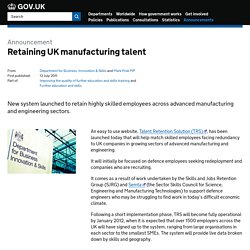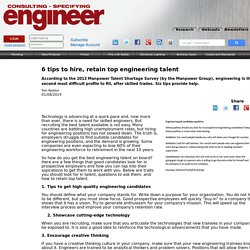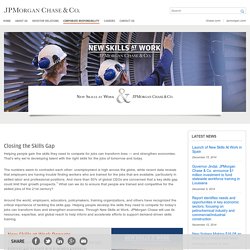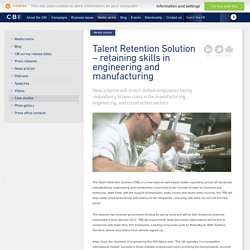

Don’t let your engineering talent stagnate. Don’t let your engineering talent stagnate By Sarah Evans A recent report from EngineeringUK revealed some startling statistics regarding the drastic shortage of young, talented engineers in the UK.

UK engineering companies need 182,000 people with engineering skills to enter the market every year until 2022.There is currently an annual shortfall of 55,000.The number of engineering graduates and apprentices entering the industry needs to double in order to meet employer demand. Whilst the spotlight remains on bringing fresh, young talent into the engineering and manufacturing sectors, it is easy to forget about the current engineering workforce. A recent report by the Institution of Mechanical Engineers shows that engineers in the UK are not being developed to their full potential. Less than half of engineers think their company succeeds in retaining talented individuals.Over 40% of engineers plan to leave their current organisation. Sources: CEB, IMechE, EngineeringUK. Retaining UK manufacturing talent - Announcements.
An easy to use website, Talent Retention Solution (TRS), has been launched today that will help match skilled employees facing redundancy to UK companies in growing sectors of advanced manufacturing and engineering.

It will initially be focused on defence employees seeking redeployment and companies who are recruiting. GetCookie.php?return=http%3A%2F%2Fwww.csemag.com%2Fsingle-article%2F6-tips-to-hire-retain-top-engineering-talent%2F7b627cd6d572b5018b7c23d2f09ed99a. Loading Tom Reddon Technology is advancing at a quick pace and, now more than ever, there is a need for skilled engineers.

But recruiting the best talent available is not easy. Many countries are battling high unemployment rates, but hiring for engineering positions has not slowed down. The truth is, employers struggle to find suitable candidates for engineering positions, and the demand is growing. So how do you get the best engineering talent on board?
1. You should define what your company stands for. 2. When you are recruiting, make sure that you articulate the technologies that new trainees in your company will be exposed to. Closing the Skills Gap. Closing the Skills Gap Helping people gain the skills they need to compete for jobs can transform lives — and strengthen economies.

That’s why we’re developing talent with the right skills for the jobs of tomorrow and today. The numbers seem to contradict each other: unemployment is high across the globe, while recent data reveals that employers are having trouble finding workers who are trained for the jobs that are available, particularly in skilled labor and professional positions. And more than 50% of global CEOs are concerned that a key skills gap could limit their growth prospects.
Recruiting and retaining your workforce. Attracting talented people into your business is never easy; many managers will find themselves sifting through several applications, desperately looking for one to leap off the page at them.

Anyone who has ever had to recruit staff will know what I am talking about: the seemingly endless quest to find a candidate with the right experience, core skills and the ability to slot straight into the business, whilst meeting the all too frequent need to source staff at short notice to fill a sudden vacancy. As such, the recruitment process can be an expensive and time inefficient task, but it needn't be. Before investing in a national recruitment agency, businesses should look to the community as a first port of call to source new staff. To my mind, traineeships are another invaluable recruitment tool for employers and should certainly be considered when looking to fill an entry level opening.
Minority support: retaining female engineers. 2 December 2014 | By Stephen Harris Industry has made progress with recruitment, but can do more to retain female engineers If you’re lucky enough to see an engineer on television these days there’s a good chance they’ll be a woman.

Large engineering firms have done a good job of unearthing the female talent from within their ranks and putting these women forward to represent their employers – and the profession as a whole – as modern and inclusive as well as technically advanced. From schools initiatives to recruitment brochures full of female faces, the industry is going out of its way to appeal to women as a way of tackling the looming skills shortage.
And there are signs that it’s beginning to work. Yet the overall proportion of working engineers in the UK who are female hovers stubbornly around six per cent. Just how many women have given up on engineering altogether even as the job market has improved is very difficult to determine. Talent Retention Solution – retaining skills in engineering and manufacturing. Media centre The Talent Retention Solution (TRS) is a new national web-based system operating across UK advanced manufacturing, engineering and construction.

Launched by the minister of state for business and enterprise, Mark Prisk, with the support of employers, trade unions and sector skills councils, the TRS will help match employees facing redundancy to UK companies - ensuring vital skills are not lost from the sector. The scheme has received government funding for set-up costs and will be fully funded by business subscriptions from January 2012. TRS will support both large and small organisations will be free to companies with fewer than 500 employees. Leading companies such as Rolls-Royce, BAE Systems, Siemens, above, and Airbus have already signed up.
Allan Cook, the chairman of engineering firm WS Atkins said: "The UK operates in a competitive international market.